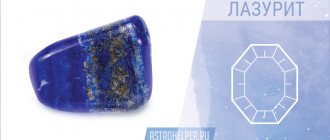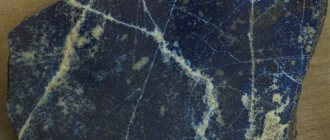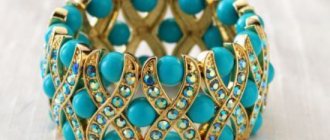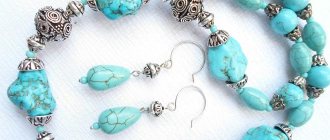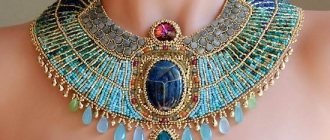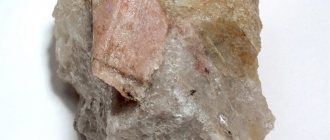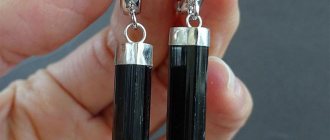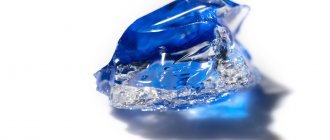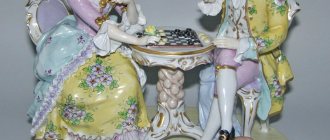A rich blue hue, golden inclusions, magical and healing properties, an ancient history dating back thousands of years - all this can rightfully be said about the mineral whose name is lapis lazuli stone.
The ancients said that he is the starry sky that fell to Earth. The analogy can be read especially in cases where veins of white marble are observed in the stone.
The history of origin goes back to antiquity. Many legends and beliefs have survived to this day.
Today, everyone can afford jewelry made from semi-precious stone, but in ancient times it was considered precious and was intended only for emperors and nobility.
In this review, we will consider what lapis lazuli is, what its properties are, its meaning, where such an amazing shade came from, what zodiac signs it suits.
What is this stone?
Lapis lazuli belongs to the semi-precious stones of the first order. It is valued for its decorative qualities: its unusual rich blue tone, golden inclusions add originality and effectiveness; one cannot help but feel the special power and magic of the stone.
This is not a gem. It is found in veins or as inclusions in other rocks, in most cases in granite. It is very rare to find lapis lazuli in the form of small crystals.
In addition to the well-known name “Lapis lazuli,” there are several more:
- Azure Stone;
- Lapis - azure;
- Lazurik;
- Bukhara;
- Heavenly;
- Lajvard;
The stone has been called lapis lazuli only since the 18th century, and before that it was more often called lapis - lazuli (it is the most expensive). Translated from Persian, azure means “blue”, so in the Middle Ages it was more often referred to as “azure stone”.
Varieties and colors
In nature, the colors of lapis lazuli can vary from delicate turquoise to deep blue and unexpected purple. The most expensive is Afghan lapis lazuli , which has a uniform blue or purple color and does not contain inclusions.
Experts divide mined minerals into several separate types:
Niili. This species is colored in a rich blue, close to indigo. The most valuable stone of the lapis lazuli family, actively used in jewelry.
Asmani. The mineral has a sky-bluish color and is cheaper than nior.
Fursi. A common species with a blue-green color.
In addition, there are minerals with various types of inclusions. Spotted varieties are suitable for creating decorative items . Elegant vases, original boxes, amulets, and various figurines made from such lapis lazuli look original and elegant. The veined-spotted mineral is considered an inexpensive type and is used in the decoration of building facades and interior walls.
Interesting! The shades of the main color depend on the number of sulfur ions: the more there are, the more saturated the blue of lapis lazuli.
Origin story
Initially, the lapis lazuli stone was discovered completely by accident. In ancient times, marble was actively mined, which was used for the construction and interior decoration of palaces and the decoration of statues.
On the border of Afghanistan and Tajikistan, work was underway to extract marble. In an area called Badakhshan, veins of an amazing blue hue were discovered in blocks of marble.
Until now, this deposit is considered one of the most inaccessible for the extraction of lapis lazuli, but over time, other sources were found, including in Russia.
But then, in ancient times, the find was very striking with its extraordinary color, so the emirs proclaimed it the most valuable nugget. By the way, the brightest and most spectacular specimens are still mined in Afghanistan.
Slaves mining the rocks were chained in the mines so that they would not be able to take out even a small amount of - not marble, but lapis lazuli! The appearance of the azure stone was considered a gift from Heaven to the East, and people began to revere it as a symbol of the supreme deity Tengri - Heaven.
Over time, the amazing bright mineral gained unprecedented fame and popularity, was initially used by the Persians, and then came to Egypt. Having conquered Ancient Rome and Ancient Greece, lapis lazuli came to European countries.
On the territory of Russia, the blue tit was mentioned for the first time during the reign of Ivan the Terrible. The blue stone in our stones was also called “lapis lazuli.”
At first it was perceived as an exotic curiosity that came from Rome, Byzantium and other countries, and then deposits of lapis lazuli were found here.
Lapis lazuli in the Catherine Palace
Catherine II made a huge contribution to the production. Over time, the stone was widely used for decoration. For example, the columns of St. Isaac's Cathedral in St. Petersburg are lined with it.
Lapis lazuli was used to decorate the hall in the Catherine Palace (Tsarskoye Selo).
Historical reference
Once upon a time in the East, where Afghanistan borders on Tajikistan, ancient people mined marble, which was the main material for the construction of ancient temples and palaces. It was there, in an area called Badakhshan, that workers discovered bright blue inclusions of lapis lazuli in marble blocks.
The emirs of that area declared the nugget to be of rare value. The slaves who mined the stone were chained to the walls of the mines in order to prevent the possibility of theft of lapis lazuli. Since that time, the peoples of the eastern steppes and mountains have revered the mineral as a symbol of the supreme deity Tengri-Sky.
The discoverers of stone used it for cladding palaces and temples. Later, from Afghanistan, the heavenly mineral gradually fell into the hands of the Persians, and then to the Egyptians. Crossing ancient Greece and Rome, lapis lazuli gradually found its way into the hands of Europeans.
- The ancient Egyptians associated lapis lazuli with the main god Amon-Ra, considering the stone a symbol of the highest heavenly justice. Therefore, the judge of ancient Egypt wore a breastplate made of stone with the hieroglyph “truth” carved on it. Products made from lapis lazuli were placed in the tombs of Egyptian pharaohs. One of the ancient rulers in whose burial chamber lapis lazuli jewelry was found was Tutankhamun.
- The Chinese and residents of other Central Asian states symbolized the blue nugget with the power of monarchs and Heaven, which stretched over every person, regardless of who he was - a mandarin, emir, peasant or warrior. There is a belief that it was from Badakhshan lapis lazuli that the boards of Moses were made, on which the prophet inscribed the commandments sent down by heaven.
In addition to its use in construction and symbolism, lapis lazuli has long been used by artists of the East and West as a colorful material. Ultramarine, a bright blue paint based on resin, water or tempera, was made from the mineral crushed into powder.
The name of the nugget has also come a long way. The Persians called the mineral “heavenly stone” or “lazhvard”. And in Europe, as in Russia, until the 18th century the mineral was called by the Latin name “lapis lazuli.” The fame of the nugget in Rus' began during the reign of Ivan the Terrible. The Russian-language names for the stone of that era were “lazurik” and “lazorevik”.
Meaning
Over the centuries, lapis lazuli has acquired many different meanings, but no one doubted that it was a “gift from Heaven” to man, because the brightness of the tone and golden inclusions were obvious evidence:
- In Ancient Egypt, the stone was associated with the supreme god Amun - Ra, and was considered the Heavenly Stone, helping to administer fair justice. For this reason, the judge had a breastplate carved from lapis lazuli with the engraving “truth”.
- Lapis lazuli was placed next to the deceased pharaohs in Ancient Egypt so that Osiris would judge them fairly. It was found in the famous tomb of Tutankhamun (according to research, it was mined in Afghanistan, from the Sary-Sang deposit). The same minerals were found during excavations in Troy. It was believed that the mineral helps to establish a direct connection with the world of the Gods. Instead of a heart, mummies had figurines of beetles - scarabs - made from this mineral.
- It is curious that before the rituals the body of the priests was often covered with lapis lazuli crushed into small crumbs.
- In China and Asian countries, lapis lazuli symbolizes absolute and fair imperial power.
- An interesting legend is about the tablets of Moses , on which the commandments to humanity were inscribed. It is believed that they are made from lapis lazuli mined in Badakhshan.
- In Eastern culture, lapis lazuli is the first assistant and protector from negativity and the evil eye.
Over the centuries, the azure stone has acquired a serious and important interpretation for any person: it is a symbol of purity (like Heaven), sincerity, justice, connection with Higher Powers and a sign of the favor of the Gods, and therefore the appearance of abilities, success and luck, luck and prosperity.
Physical properties
When studying the characteristics of lapis lazuli, it became clear that the nature of its origin was magmatic. It has a complex composition.
Its structure includes the following elements:
- Aluminum;
- Oxygen;
- Sodium;
- Sulfur;
- Sometimes calcium, parts of pyrite or fawn spar.
Below is a table that contains all the characteristics of the stone:
| Name | Description |
| Chemical formula | Na[(AlSiO4)SO4] |
| Mohs hardness | 5,5 – 6,0 |
| Density | 2.38 – 2.42 g/cm3 |
| Refractive index | 1,5 |
| singonia | Cubic |
| Kink | Grainy and conchoidal |
| Cleavage | Does not have obvious expression |
| Impurities | Pyrite and spars |
| Shine | glass |
| Transparency level | Translucent |
| Colors | All shades of blue with tones of violet, sometimes blue-bluish |
| general description | Sodium – calcium silicate with sulfur and sulfate ions |
It gets its recognizable bright blue color from sulfur, which is part of the composition. The more it is, the richer the shade. Prits form golden-colored veins, which people in ancient times mistook for gold.
Chemical properties and composition
Lapis lazuli is a sodium aluminum silicate containing sulfur.
Chemical formula –n(Na2O·Al2O3·mSiO2)·Na2Sx, where n = 2-3; m = 2-3; x = 1-5.
When exposed to hydrochloric acid, it releases hydrogen sulfide, which is distinguished by the smell of rotten eggs. At the same time, Baikal lapis lazuli hisses due to inclusions of marble.
Field
The oldest place is the border of northern Afghanistan and Tajikistan: Badakhshan province. Work is still underway there, and the profit is provided by the Taliban movement and political figures.
Since lapis lazuli is of volcanic origin, it is mined in places where there were previously volcanoes:
- In Russia, the Baikal region (southern part) is considered the place for blue tit production; a lot of it was found along the banks of the Slyudyanka River. The appearance of the crystals is very similar to those from Badakhshan, but the pattern is a little blurred.
- There is another Afghan deposit , near the Pamir Mountains, but the minerals there are not of the same high quality as those from Badakhshan.
- Lapis lazuli is also mined in other countries of the world: Africa, Chile, Namibia, India, China, but the quality there is also not very high and the value is less.
Sources
Only Afghanistan and Pakistan produce the best lapis lazuli in commercially interesting quantities. The Colorado stuff is pretty good, but it's limited in quantity.
- Badakhshan, Afghanistan. It is home to one of the oldest operating mines in the world (7,000 years old). Lapis lazuli occurs as large blocks and crystals in a white matrix. Source of the world's finest lapis lazuli.
- Pakistan. Lapis lazuli is a solid dark blue color, without the white flecks of calcite, only with an admixture of coppery yellow pyrite.
- Colorado. Stringers of dark-colored limestone with large amounts of pyrite occur on Mount Italian in the western part of the state.
- California. Gray-blue lapis lazuli with white spots.
- Studenka River, Mongolia. Blue lapis lazuli with pyrite.
- Chilean Andes. A mixture of gray and blue. Lapis lazuli is inferior in color to Afghan material.
In addition, lapis lazuli is found in Italy, Labrador (Canada), and Mogok (Myanmar).
Lapis lazuli from Mount Italian, Colorado, USA, on display at the Denver Museum of Nature and Science, Denver, Colorado
Varieties, color differences
The lapis lazuli stone has completely different shades of blue: from a thick and dark shade, with a purple color, to greenish blue.
There are minerals of a single color, but more often with inclusions, veins consisting of pyrite, spar of a grayish or white color.
The presence of the latter is a sign of low quality.
The most valuable and high quality is the blue tit from Badakhshan.
Afghan national stone is classified into groups:
Niili
The hue is rich, bright, blue, often with golden-colored pyrite veins. The most expensive, the cost of processed mineral inserted into jewelry is at least $10 per gram.
Asmani
Almost blue color, sometimes light undertones of blue.
Sufsi
It is distinguished by the presence of greenish tones and has inclusions. The cheapest.
Russian lapis lazuli resembles Afghan stones. Chilean and Pamir ones are paler.
Asmani and sufsi are used to make jewelry and are purchased for private collections; they are considered the best specimens in the world.
Important: Azurmalachite is often confused with lapis lazuli; it is a mixture of lapis lazuli and malachite and has a greenish-blue characteristic color.
The value of lapis lazuli
Lapis lazuli from Afghanistan (solid blue) and Chile (melange), cabochons from 5 to 25 carats
The value of lapis lazuli is determined almost exclusively by color. Deep, rich blue with purple tones is preferred. Fine-grained, uniform specimens may have a smooth, highly polished surface not seen in lower quality minerals.
Inclusions of calcite almost always reduce the value of a stone, while inclusions of pyrite increase it in the minds of many collectors and jewelry lovers. While enthusiasts may debate how much pyrite should ideally be in lapis lazuli, most will agree that the less calcite, the better the stone. Calcite can be seen as streaks or spots in a dark blue color. A large proportion of inclusions gives the stone an overall lighter blue hue.
The quality of polishing and cutting also affects the cost.
Magic properties
Lapis lazuli is suitable for those who dream of positive constructive changes in their lives, but do not dare to take the right and active steps. It is advisable to purchase this stone as a talisman and an assistant in gaining strength.
The owner of the stone will notice positive changes in a short period of time, and his environment will also be cleared of envious and negative people.
If you have been unable to have offspring for a long time, then jewelry made from celestial lapis lazuli will help you conceive and bear fruit successfully and without complications. It should not be removed during labor.
The owner becomes a very intuitive and insightful person, quickly recognizing lies. Lapis lazuli will help harmonize relationships in couples, and help lonely people find a soul mate.
Lovers of meditation and solitude have long used it to connect with Higher Powers and gain peace of mind and tranquility.
The stone is suitable for philosophers, people with creative professions, doctors, lawyers, writers, practical psychologists, hyperactive children who require attention and timely reassurance.
Medicinal properties
Even in ancient times, healers felt and identified the positive effects of lapis lazuli on the body. They treated anorexia and removed poisons and toxins from the body.
Lithotherapists in the modern world recommend wearing a “star” stone for the following ailments:
- If you look at lapis lazuli for 6 – 8 minutes a day, your vision will begin to recover.
- For baldness and for thicker hair, you should wear earrings with this mineral.
- Neuroses , anxiety, insomnia and hypertension will go away forever if you wear a necklace made of azure stone.
- A silver brooch or pendant with a stone will help people diagnosed with asthma, chronic diseases of the lungs and bronchi, and suffering from attacks of radiculitis.
- Those who purchase blue tit from Badashkhan will be able to get rid of stomach and duodenal ulcers.
- As a preventive measure, you can wear a stone and cleanse the blood, eliminate inflammation in the lymphatic system. It is advisable to wear a ring with lapis lazuli on your left hand.
- For any damage to the skin , including wounds, cuts, burns, apply a stone to the affected area.
- If you take the powder , such a natural remedy will cause vomiting in case of poisoning.
Even in ancient times, beads were worn by pregnant women so that the period of bearing a child would be successful, there would be no miscarriage, and childbirth would be without complications.
Types of mineral and its use
Like any other mineral, lapis lazuli is known for its healing properties. In ancient times, lapis lazuli powder was used not only by artists, but also by healers. The latter believed that with the help of this blue mineral powder it was possible to remove parasites and various poisons from the human body.
Healers of Medieval Europe assumed that the mineral was very effective in cases of exhaustion, since wearing any jewelry made from it helped to return to normal weight.
Today, many experts believe that lapis lazuli helps restore vision, and also allows the eyes to rest and relax. For these purposes, you just need to look at the mineral several times a day for five minutes.
Also, wearing lapis lazuli jewelry helps hair grow and prevents baldness.
Necklaces and beads made of blue gems help their owner cure hypertension, get rid of insomnia, nervous disorders, and nightmares. A pendant or brooch made of lapis lazuli saves its owner during attacks of radiculitis, relieves bronchial asthma and ulcers. The most powerful medicinal properties are lapis lazuli mined in Afghanistan.
A gem of a heavenly shade must be worn by people suffering from ailments of the respiratory system, including those with allergies. In addition, it is believed that the natural mineral is capable of purifying the blood, so in the past it was often applied to wounds, this ensured their speedy healing.
Lapis lazuli is classified according to the jewelry and decorative qualities of the mineral. There are such types of blue tits as niili, asmani, sufsi. They all have different values. The cost of lapis lazuli is largely influenced by its shade, which can vary from sky blue to blue-green.
The color of lapis lazuli depends on where it is mined. If the rock is mined in Afghan deposits, the lapis lazuli contains golden inclusions of pyrite. The color of the mineral mined on Baikal has various shades of blue with whitish stripes and inclusions, forming a beautiful intricate pattern.
| Classification sign | Types of lapis lazuli | Characteristic | Value |
| By color | Niili | Rich blue color, bordering on violet. Plain or with golden veins. | High |
| Asmani | Sky blue shade. There are light blue specimens. | Average | |
| Sufsi | Blue-green color. Possible inclusions. | Low | |
| By texture | Homogeneous | Uniform texture. Blue or purple color. There are no inclusions, spots or stripes. | High |
| Spotted | Bright color with small inclusions of foreign impurities. Heterogeneous structure. | Average | |
| Spotted with streaks | Combines the previous 2 types of minerals. |
Despite its fragility and low density, the scope of application of this stone is practically unlimited. Lazuli is widely used for making:
- Interior items. The stone is actively used for decorative purposes. Lapis lazuli of a deep blue hue is used to make floor and table vases, elegant candlesticks, boxes, and various figurines. Most often, spotted mineral is used for this.
- Jewelry. Thanks to its rich, noble hue, lapis lazuli is a stone that seems specially created for making jewelry. Rings, watches, brooches, earrings, and necklaces are made from it. Lazuli goes well with gold. Jewelry made from niili is especially highly valued.
This stone has another area of application. The mineral is used as a facing material. Countertops are made from it. Stone is also used to decorate the walls and decorate the external and internal elements of the premises.
People have long believed in the healing power of lapis lazuli. According to hereditary healers, wearing earrings, brooches, necklaces or bracelets with blue tits will protect a person from the evil eye and damage, give him mental strength and allow him to resist negative energy. The healing properties of lapis lazuli have found a place in modern medicine.
Its use helps:
- normalize blood pressure and nervous system function;
- facilitate the course of pregnancy and childbirth;
- prevent miscarriage and premature onset of labor;
- improve blood flow;
- stop the inflammatory process and pain syndrome of various origins;
- stimulate the activity of the thyroid gland;
- eliminate hyperthermic syndrome and signs of colds;
- strengthen the body's defenses;
- resist the effects of pathogenic agents;
- improve hair condition;
- stop the bleeding;
- accelerate the healing of wounds and abrasions;
- relieve attacks of bronchial asthma, as well as inflammation of the tonsils and respiratory organs;
- eliminate back problems, disorders of the digestive tract;
- improve visual function.
If there is no therapeutic effect when using lapis lazuli, most likely, errors were made during the application process. To achieve a positive result, you need to follow a number of recommendations:
- to improve visual acuity and get rid of heavy thoughts, continuously look at the nugget 2-3 times a day for 5 minutes;
- to normalize mental balance and sleep, wear a necklace with indigo-colored lapis lazuli;
- To stop hair loss and increase hair volume, wear earrings with lapis lazuli every day;
- to eliminate pain, apply blue tit to the sore spot 2-3 times a day for 5-10 minutes;
- to treat the respiratory system and relieve attacks of radiculitis, wear a pendant or brooch with lapis lazuli;
- to relieve attacks of bronchial asthma, wear a bracelet or ring with lapis lazuli on your right hand;
- to cleanse the lymph and eliminate inflammation of the lymph nodes, wear a ring with blue tit on your left hand;
- To ease the course of pregnancy and childbirth, as well as to prevent miscarriage, constantly wear beads with lapis lazuli.
Lapis lazuli is a semi-precious ornamental stone of the first order.
In jewelry, the greatest demand is for dark blue specimens without noticeable light inclusions, that is, dense dark blue, cornflower blue and violet lapis lazuli. They are processed with cabochon or plates. For low-grade stones, white, blue and gray spots are allowed. Expensive samples contain sparkles of golden-colored pyrite.
As a soft and fragile stone, lapis lazuli is very easy to process, and due to its beauty it is quite popular. In addition to jewelry, vases, boxes, figurines, inlays, and cladding are made from it.
Ground lapis lazuli is a natural ultramarine pigment known as lapis lazuli. Since ancient times, it has been widely used in painting to create oil paints, first in the countries of the East, from where it later became widespread in Europe, where it was especially popular among medieval artists. The pigment was used in painting until the beginning of the 19th century, after which it was replaced by a cheaper artificial analogue.
Who is suitable according to their zodiac sign?
To get the maximum effect and really “make friends” with a stone, you should combine its properties with your zodiac sign, it is important who the person is according to the horoscope.
Lapis lazuli is especially suitable for Libra . Helps make responsible and complex decisions, helps increase self-esteem and develop hidden talents and abilities. But you should wear jewelry with stones all the time (except for periods of cleaning).
He calms and pacifies Sagittarius’ To avoid getting irritated and saying unnecessary things, wear the stone to events, signing contracts and business meetings.
Other zodiac signs can also wear the stone, but not more than five hours a day. And the representative to whom the “blue” mineral is absolutely indifferent is Capricorn , will not cause harm, but there will be no benefit either.
Zodiac compatibility
Astrologers strongly associate lapis lazuli according to the zodiac sign with Sagittarius. This is an ideal jewelry stone for the most hot-tempered, fickle and restless Fire sign, despite the fact that it belongs to the Earth minerals. Lapis lazuli jewelry can be worn by Aries, Pisces, and Aquarius. According to the horoscope, he is suitable for Libra.
But for representatives of the most “powerful” fire sign - Leo, and the most unpredictable and out-of-the-box thinker - Scorpio - the blue tit is contraindicated.
| Zodiac sign | Compatibility |
| Aries | + |
| Taurus | + |
| Twins | + |
| Cancer | + |
| a lion | + |
| Virgo | + |
| Scales | +++ |
| Scorpion | + |
| Sagittarius | + |
| Capricorn | — |
| Aquarius | + |
| Fish | + |
(“+++” – fits perfectly, “+” – can be worn, “-” – is strictly contraindicated)
Talismans and amulets
The stone can be worn under clothing or as jewelry. He is capable of collecting all the negativity directed by envious people or simply unkind people. When working in a team, it is better to have silver jewelry.
If the mineral is in gold, it will attract love and good luck to the owner. Beads, bracelets and pendants help to radically change your destiny.
If it is frameless, it can alternatively be carried in a handbag or in an inside clothing pocket.
If there are several stones in a product, then their cleansing power is enhanced.
Women's jewelry
Products with lapis lazuli are always interesting, beautiful and add charm and charm to the image of their owner. The gem is rarely combined with others because the rich blue color is difficult to harmonize with others. There are several reasons for this approach:
- The saturation of blue requires the brightness of the partner color, and harmony is lost.
- The surface pattern is not uniform; it is dotted with ornate, unique patterns. It is difficult to find similar patterns among different minerals.
- The sophistication of jewelry is lost, they become provocative and catchy. Such products are difficult to combine with a certain style of clothing.
Jewelry makers try to leave lapis lazuli alone, allowing it to play with its iridescence and be proud of its uniqueness. But one cannot deny a mineral the opportunity to find friends among gems. What combinations are selectable:
- With carnelian. Bracelets made of two beads create an interesting mood. The richness of lapis lazuli is softened by carnelian. The result is a calm color and an unusual transition from one shade to another.
- With mother of pearl. The shine of mother-of-pearl beads adds shine to lapis lazuli and adds color. The decoration looks elegant and feminine.
- With turquoise. The color changes, becoming green-blue, the pattern approaches the color of a sea wave.
- With coral. Minerals are selected in the same tones or in contrast, some highlight the beauty of others.
- With pearls. The round beads of the two gems begin to merge and change color. The mother-of-pearl shine of pearls and lapis lazuli creates a heavenly halo, giving the impression that the air around is also colored.
Designers advise women to purchase not just one piece of jewelry, but a set. Then deep blue will become the background, the basis of the clothing style. Which sets would make a great decoration:
- beads and bracelet;
- ring and earrings;
- earrings and beads;
- ring and pendant.
You can buy a complete set, all possible items, but here the designers advise limiting yourself. Putting on all types of jewelry at once is not stylish: you can get lost among the blue stones and become a background for them. They will admire the beauty of the stones, but the owner will not notice the attractiveness.
The metal frame is of great importance. It must be united. Gold-cut jewelry is not recommended to be placed next to a silver frame. Dissonance is created, the meaning of decoration is lost, the person does not acquire individuality in appearance.
Another tip for women concerns the shape of jewelry. Balls do not fit with flat squares or other geometric shapes. Round beads look great with rounded lines, sharp shapes with sharp angles. Identical shapes are perfectly combined into sets, even if their volumes are different.
Other Applications
Souvenirs in the form of figurines and figurines are made from lapis lazuli. You can see expensive boxes made by real craftsmen.
Sometimes ashtrays are made from it as a gift option. Previously, they were actively used in temples and temple paraphernalia.
Taking note of the experience of the ancient priests, Europeans in the Renaissance again began to turn the stone into powder and make paint with its particles for painting.
This is how ultramarine came into being. Natural was used in painting until the 20s of the 20th century. Then it was replaced with an artificial one.
Price and care
If the product is inexpensive, then its maximum price will be 10 - 20 dollars. Gold and silver jewelry with lapis lazuli can be very expensive: from several thousand rubles to several thousand dollars.
For one gram you can pay either 1 or 10 dollars.
A ring or earrings made of silver with lapis lazuli will cost about 7 thousand rubles, and a stone in a gold frame will cost about 15 thousand rubles. and higher. It is advisable to purchase the mineral a week before the full moon, and put it on 14 days later.
It is important to properly care for the stone:
- Store in a box.
- Periodically rinse with tap water and clean.
- Heavy dirt can be removed with baby soap.
- After washing, wipe dry with a napkin.
- You cannot drop the stone, as it will break.
Price
The times when lapis lazuli was comparable in value to gold are long gone. Today it is a common ornamental stone. Jewelry and crafts made from it are sold in jewelry stores and souvenir shops.
However, the price of lapis lazuli products is quite high. So, for a ring made of solid stone you will have to pay 15–20 thousand rubles . Exclusive beads made of heavenly stone will cost 10–25 thousand rubles . Earrings can be bought for 4 thousand rubles . The final cost consists of the price of the type of mineral, the complexity of the work and the material of the frame.
View this post on Instagram
Posted by Minerals • Crystals • Stones (@arthome.etc) Jul 18, 2019 at 7:50 PDT
How to distinguish from a fake?
Lapis lazuli is often counterfeited. They give it as colored chalcedony, jasper and cacholong. Glass cabochons in shades of lapis lazuli and colored polymer clay are similar to the mineral.
To find out, you need to dip a stone in water. The fake will be covered with small drops, and the natural stone will become wet gradually.
Depending on the lighting, it is also easy to identify a fake: it always glows the same, and a natural mineral dims in the evening light.
Difference from the original
Lapis lazuli is a coveted gem. They often try to replace it with other breeds. Which stones easily turn blue?
- jasper;
- synthetic spinel.
You can distinguish the original at home. Several ways to check:
- The surface of the sample must be wetted. On the original, the top layer will be moistened evenly. The fake will be covered with drops.
- Place in the sun. Natural lapis lazuli shimmers brightly under the rays and changes (darkens) under artificial lighting. Counterfeits are the same everywhere.
Price cannot become a parameter for determining originality. The average cost of 1 gram is $2–3, that is, even a voluminous product will not be too expensive. Afghan lapis lazuli is considered the most valuable. It is abundantly dotted with gold inclusions and does not lose its shine and brightness.
What stones does it go with?
It is advisable to know how lapis lazuli stone coexists with other minerals:
- It goes best with earth stones: jade, malachite, agate and turquoise.
- Satisfactory compatibility with “water” stones: opal, pearl, aquamarine, emerald.
- Reacts neutrally to “air”: amethyst, crystal, beryl.
- It is not recommended to combine with “fire”: garnet, ruby and diamond.
How to care for lapis lazuli
As a soft and fragile mineral, lapis lazuli must be protected from mechanical damage and shock. Products with it are stored separately from other jewelry, best of all - in velvet bags.
Lapis lazuli does not like water, so water procedures are contraindicated for them. To clean the stone, use a soft cloth. Chemical cleansers are also not recommended.
Interestingly, unlike many other stones, lapis lazuli is resistant to sunlight. From time to time, it is recommended to leave jewelry in the sun to recharge it with energy.
Fake diamond
Sodalite
There are several types of fake stones: sodalite, colored lapis lazuli and dumortierite. The latter does not have that special shine and silvery sparkles.
Sodalite is transparent, you can see light through it. The colored mineral will give itself away as a colored mark after being passed over a wet surface.
